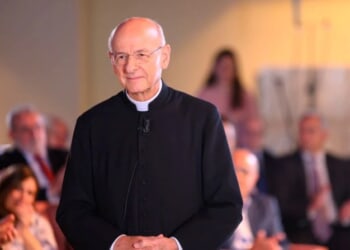Desi Arnaz: The Man Who Invented Television
By Todd S. Purdum
Simon & Schuster | 368 pages | $29.99
Does the world really need Desi Arnaz: The Man Who Invented Television? I guess not. For one thing, the subtitle, like many book subtitles these days, is wildly hyperbolic. For another, we already have Arnaz’s charming 1997 memoir, A Book, which I read at the time with great pleasure and which provided what seemed to me a thoroughly sufficient account of his life. Let me make it clear that, as someone who, along with millons of others, has been a devoted I Love Lucy fan since my long-ago childhood, I’m a sucker for every biography, history, documentary, or movie (cf. Aaron Sorkin’s surprisingly entertaining Being the Ricardos, 2021) that professes to shed new light on that pioneering sitcom and the people who made it. Yes, there have been times when I’ve gotten satiated. There’s been a lot of this stuff. But the only thing I’m satiated with these days is the incessant drumbeat of left-wing wokeism, Jew-hatred, and Trump Derangement Syndrome. So this was a perfect time to escape once again into the world of I Love Lucy, and, particularly, into the colorful life of a Cuban refugee turned naturalized American citizen who adored his adopted country and who, although he didn’t invent TV, played, in the words of author Todd S. Purdum, a “seminal role” in its “nascent years.” No, Desi Arnaz: The Man Who Invented Television isn’t necessary, but it’s a delightful diversion.
Even its first third or so, which recounts Desi’s life before television, is absorbing. “Raised as a prince,” as Purdum puts it, by the first family of Cuba’s second city, Santiago (his father was mayor), he was forced by the Revolution of 1933 to flee the island, penniless, at the age of 16; in the States, his English shaky and his musical training nonexistent, the plucky, self-assured youth nonetheless founded a band that within a few years was playing top venues around the country. After the songwriter Larry Hart caught a performance, Arnaz found himself starring on Broadway in the Rodgers & Hart musical Too Many Girls; and when he went West to appear in the 1940 movie version, he met his co-star, RKO contract player Lucille Ball. They fell in love. They married. And had two big (and intimately related) problems: his chronic infidelity, and careers that kept them constantly apart — her due on soundstages at dawn, him singing at nightclubs (not to mention swilling booze, smoking cigars, and pinching chorus girls) until long after midnight. So when CBS offered Lucy a weekly comedy series in the new and infra dig medium of TV, Lucy, desperate to settle down and start a family, said yes on one condition: that Desi play her husband.
I Love Lucy was born.
This was when Desi came into his own, facing down one challenge after another. One of them was the then-standard network-TV model: a show was broadcast live from New York to the overwhelming majority of Americans who lived in the east; the coaxial cable not yet having been completed, West Coast viewers were treated at a later date to an inferior filmed copy (or “kinescope”) of that live feed that had to be flown across the continent. Determined to stay in L.A., Desi had the idea of filming the show on the Coast, as if it were a theatrical motion picture, and sending prints to TV stations nationwide so that a given episode could be aired everywhere on the same date — with superb audio and video, no less. “At a stroke,” writes Purdum, “Desi had effectively given birth to the business model that would become the industry standard.” The practice of recording — and hence preserving — episodes on high-quality film, moreover, would soon make possible two major innovations: reruns and syndication.
Another challenge was this: theatrical motion pictures were invariably filmed using one camera at a time, often with numerous retakes, and always with pauses between shots to reposition the camera and lights. But situation comedy, Desi knew, would work best if shows were shot in sequence in front of an audience whose live laughter could be recorded along with the actors’ dialogue; long breaks — and endless repetitions of the same lines — would be deadly to the comic impact. Thus was born the three-camera shoot, which also became standard for sitcoms (until single-camera series like 30 Rock and Curb Your Enthusiasm came along). At times over the subsquent decades, Desi would exaggerate his own role in coming up with the three-camera process; in fact Karl Freund, the inventive veteran cinematographer whom he wisely hired to film I Love Lucy — he’d previously pioneered dolly shots and process shots — played a major part in overcoming the difficulties of a three-camera shoot. In any event, I Love Lucy was not, as has been maintained for decades, the first TV series with an audience to use three cameras: the game show Truth or Consequences was.
Whatever the case, Desi did a lot for which he deserves immense credit. He had an instinctive talent for casting, for management, and for dealing with the network and sponsor. With no high-level business background or training, he made sophisticated decisions involving such things as “vertical integration” — i.e., forming multiple firms to maximize profit. According to series writer Bob Carroll, he was a gifted script diagnostician, possessed of “a great sense of comedy which his wife did not have. Lucy did not know what was funny in concept. When she did it, she was the greatest in the world. But she didn’t know.” Director Bill Asher agreed. At table reads, “Desi would really control the table …. He would make most of the suggestions, and most of them were right.”
And when I Love Lucy premiered, Desi’s choices were more than vindicated. The show’s success exceeded anyone’s dreams. It “became the first program in the history of television to reach ten million homes, or 63.2 percent of all the television sets in America.” But while the American public fell in love with Lucy, it was entirely unaware of the scale of Desi’s contribution. To address that sore point, he eventually took the title of executive producer away from the showrunner, Jess Oppenheimer, and took it for himself.
A unique problem arose in the second season. The Arnazes, expecting their second child, wanted to write the pregnancy into the series. At the time, the topic was considered indelicate, and Desi went to the trouble of soliciting the opinions of three religious advisors — a priest, a minister, and a rabbi — none of whom had any problem with a story arc about pregnancy. But the sponsor, Philip Morris, apparently having more delicate sensibilities than the clergymen, sent down word that such material would be forbidden. An adamant Desi responded to the edict with a remarkably gutsy letter (printed in Purdom’s book) to the company chairman himself, Alfred Lyon, who instantly penned a memo to his staff: “Don’t f*** around with the Cuban!” The pregnancy arc smashed all TV viewership records, and the climactic episode, in which Lucy gives birth, received even higher ratings than the inauguration of President Eisenhower, which took place the following day.
The third season brought a new problem. The gossip columnist Walter Winchell announced on his radio show that Lucy, according to a government leak, was a Communist. Lucy panicked. Desi leapt into action, phoning J. Edgar Hoover, a race-track acquaintance, to ask if the FBI “had any grounds for concern about Lucy.” It didn’t. Desi then called Lyon, who promised his solidarity. And finally he contacted the House Un-American Activities Committee — which had recently cleared Lucy in closed session — and demanded, successfully, that her innocence be publicly proclaimed at a press conference. The incident came and went quickly, but it traumatized both Lucy and Desi (who were Republicans and Eisenhower voters). “For the rest of her life,” writes Purdum, “she never so much as cast a ballot.” For Desi, the crisis released “personal demons … that would make it hard for him ever again to rise to the occasion with quite such grace and skill.”
Still, the firsts kept coming. The new Pontiac in which the Ricardos and Mertzes drove to California in season four was the first known example of product placement. Sequences of the car crossing the country included TV’s first process shots. Meanwhile, the Arnaz’s company, Desilu, expanded far beyond I Love Lucy, and in 1957 — by which time the weekly half-hour had morphed into the less frequently aired (and less funny) Lucy-Desi Comedy Hour — Desilu bought the old RKO lot, at which Lucy and Desi had met on Too Many Girls; the purchase meant that Desilu now had “three separate lots, thirty-six soundstages, and more than four hundred and fifty offices — a million square feet of space over sixty-three acres in three locations — more than Paramount, Warner Bros., Fox, or MGM, making it the largest motion picture and television production plant in the world.”
Alas, the triumphs couldn’t last forever. In 1960 the Arnazes divorced — very amicably — and Desi sold Lucy his share of Desilu. She moved on to another husband and other, lesser sitcoms; he remarried too, but continued to cheat, to drink hard, and to smoke cigars, dying of lung cancer in 1986 at the age of 69. Although in his later years he mostly squandered his multifaceted genius for TV, the positive side is that his relationship with Lucy actually improved greatly after the divorce, and he never stopped being a proud and devoted father. In Desi Arnaz, Todd S. Purdum — despite his unfortunate fondness for identity-politics clichés (Arnaz was “a breakthrough cultural figure in a country that would soon be transformed by growing social justice activism and a greater acceptance of diversity as a strength”) — has given us a worthy biography of a man who happens to have been not only our “first Latino television star” and “first Latino television executive” but, far more important, a touchingly sincere patriot who, at a 1954 tribute, declared with palpable emotion that no other country in the world would ever have given him the extraordinary opportunity that America had. No, Desi Arnaz may not have invented television, but few native-born Americans have made more significant contributions to it — or to modern American popular culture generally — than did this bold, brilliant autodidact from across the Florida Straits.
READ MORE from Bruce Bawer:

![Man Arrested After Screaming at Senators During Big Beautiful Bill Debate [WATCH]](https://www.right2024.com/wp-content/uploads/2025/06/Man-Arrested-After-Screaming-at-Senators-During-Big-Beautiful-Bill-350x250.jpg)














